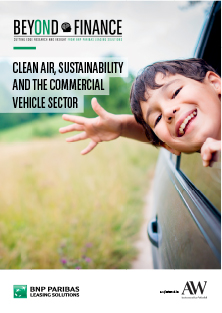By Jean-Michel Boyer, CEO, BNP Paribas Leasing Solutions UK
In 2017, to be environmentally friendly is a matter of ecological consciousness – and international law. The UN’s Paris Climate Agreement has 195 signatories as of September 2017, each committed – in their own way and according to their own standards – to reducing the impact of global warming. For example, within the EU, wide-ranging and extensive targets have been agreed, including that greenhouse gases will be lowered by 40% from their 1990 levels, and by 80% to 95% by 2050.
As the fossil fuels that power conventional automobiles are the single most significant contributor to greenhouse gas proliferation, the global commercial vehicle industry is certain to experience significant change. Arguably, this is both legally and operationally necessary: the 2015 Volkswagen testing furore – when the company was found to have violated the US Clean Air Act with some of its diesel engines – was a clear indication that the market needs to take emissions more seriously.
If you’re running a vehicle dealership, you must start thinking about how your business model can accommodate a world of increasing environmental consciousness – and environmental regulation. Working towards a sustainable emissions policy won’t be a simple or uncomplicated task, but for the sake of legal compliance, reputation, and profitability, it’s a necessary one.
A vehicle for change?
Before working to reduce your emissions, it’s vital to understand how you can reduce them. This isn’t every dealership’s specialist subject, after all.
There are multiple ways to tackle emissions, but hydrogen-powered and electrically charged vehicles (ECVs) represent a particularly high-profile method. For some time, they represented more theory than reality. Technology, however, has caught up, and if they were once too expensive, impractical, or far-off to integrate into a business model, they are a viable option today. By reducing (and in some cases eliminating) a vehicle’s dependence on petroleum, they also reduce carbon dioxide output and contribute to better air quality.
Several high-profile car manufacturers are working on commercial ECVs in various stages of development. It should come as no surprise that Tesla – which built its brand on electric cars – is making waves in this field: CEO Elon Musk describes its new all-electric Semi truck as a “beast”, with high weight capability and a long range, while a Morgan Stanley analyst describes it as “the biggest catalyst in [the field] in decades”. Nor is it especially shocking that Toyota, which pioneered and popularised the hybrid car, would go completely electric with Project Portal – a hydrogen-powered 18-wheeler that uses an electric motor.
Other organisations are working on their own prototypes: Mercedes-Benz and Daimler Trucks are collaborating on a prototype Urban eTruck, a pure-battery-electric vehicle designed for urban deliveries, and with a range of 200 kilometres. But this is expected to go into production in the early 2020s, and the other projects mentioned are on a similar timeframe. There are options available on the market right now.
For example, Nissan’s e-NV200 has been on the market since 2014 – becoming Europe’s top selling electric van in 2016. Absent space-consuming components like the internal combustion engine, it’s much easier to maintain and produces no emissions. Several fleets are active today. As of January 2017, Renault’s Pro+ range also offers the fully-electric Kangoo Z.E. and Twizy Cargo.
The question for dealerships is essentially this: if you have the resources, the inclination, and the right mentality, what is preventing you from offering ECVs to your business customers?
Barriers to ECV adoption
Any advocacy of ECVs must come with the caveat that integrating them into an organisation’s fleet will not necessarily be a clean and easy process. There are several barriers to purchase for your customers – and any improvements to air quality will be cold comfort if electric vehicles end up costing significant amounts of money and preventing them from buying more over the long-term.
For instance, the battery life of ECVs remains a serious concern: while it’s improving all the time, performance over long distances is vital for fleet managers. Hydrogen power won’t solve this problem: fuel cells can be less durable than the alternatives, and refuelling stations are scarce. These are problems, and may put off some customers, but time, money, and innovation ought to solve them.
The most pressing issue, however, is perhaps the sheer cost of converting to an environmentally-friendly fleet. There’s no getting around the fact that ECVs are more expensive than their petroleum and diesel-based equivalents. The upfront cost of replacing – or supplementing – a fleet with these vehicles can be daunting for many businesses and organisations. Many could be faced with a painful choice: adapt to a low-emissions era and risk breaking the bank; or fail to do so, and face longer-term consequences in the process.
Helping customer to square this circle should be a priority for dealerships. But how can this be done?
Financing the fleet of tomorrow
Alternative methods of financing fleets have long been available, and they are steadily growing in popularity. In July 2017, The Finance & Leasing Association valued new business in the UK commercial vehicle finance and leasing market at £540 million.
It’s easy to understand why: by reducing the upfront purchase price and spreading it over the cost of a multi-year agreement, leasing removes the biggest barrier to ECV acquisition. It offers both the dealership and the end-user greater flexibility. If, as a dealership, you want to roll maintenance and support into the agreement, you can; if you want to allow your customers to upscale their fleets in accordance with their requirements, you can. As technology leads to the development of more sophisticated ECVS, customers are also incentivised to use leasing as a means of gaining access to the latest vehicles.
Using these finance agreements, dealers are empowered to become eco-friendlier, forge stronger relationships with customers – and give those customers have every reason to come back to them. Leasing also supports the emergence of a ‘circular economy’ – where base materials are reused for vehicles and parts alike. This ensures that natural resources don’t deplete too easily, while vehicles remain affordable. Leasing can support this process by allowing vehicles to be returned and reused.
An age of environmental consciousness, technological innovation, and tightening legal requirements presents unique opportunities and unique risks for the commercial vehicle market. Adapting to this will take effort, initiative, and some degree of open-mindedness. It will nevertheless be worth it. The market has already taken the first steps towards a future where sustainability isn’t just morally and legally necessary, but commercially viable. The rest of the journey will take some time – but it’s better to ride along than to lag behind.
We are committed to your business growth. Our competitive finance solutions can help you capitalise on new opportunities. Contact us today to discuss your needs with a member of our team.
Share post:
Featured in ...
Media contact
Suhale Vorajee
Head of Marketing and Communications
BNP Paribas Leasing Solutions UK
T: 01179 100 895
E: click here






